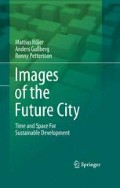Abstract
When we discuss resource use in the future city, the main point of departure for this book is household consumption. That consumption also becomes our focus. This means that we concentrate on the effects of the consumption choices made by the households to a greater extent than the effects of pure efficiency gains in the production process. However, a large part of the resource use is obviously affected by how those goods and services are produced. So we have chosen to discuss even this area, if only summarily. This chapter discusses energy use that is not directly affected by household choices, that is the potential in the actual agricultural, industrial and service sector production.
Chapter written by Mattias Höjer. Section on “Foodstuffs Production” written with Christine Wallgren and Ronny Pettersson. Section on “Durable Goods” is written by Björn Granberg.
Access this chapter
Tax calculation will be finalised at checkout
Purchases are for personal use only
Notes
- 1.
Swedish Energy Agency, Energy in Sweden 2009, 2009.
- 2.
Atkins, P. and Bowler, I. Food in society: economy, culture, geography, 2001, pp. 27–29.
- 3.
Atkins and Bowler 2001.
- 4.
Statistisk årsbok (Statistics annual) 2009.
- 5.
Atkins and Bowler 2001, pp. 29–32.
- 6.
Ibid., pp. 74–75.
- 7.
Molin, L. Mejerisektorn och den nya biotekniken (The dairy sector and the new biotechnology), 2002, pp. 37–39.
- 8.
Björklund, J., Limburg, K., Rydberg, T. “Impact of production intensity on the ability of the agricultural landscape to generate ecosystem service”, 1999.
- 9.
- 10.
See Chap. 28.
- 11.
Categories according to COICOP; Energy according to NR: Category 0511(Furniture, lighting, etc.): 8791 TWh; Category 07111 (cars, new): 6542 TWh; Category 07112 (Cars, used): 4624 TWh.
- 12.
Product life cycle is the time a product exists on the market, which in many cases can be a rather long time. The internal combustion engine and the refrigerator compressor have been on the market for the most part of a century, while the radio tube and slide rule have been replaced by other products.
- 13.
- 14.
Rosenberg, N. Exploring the black box, 1994.
- 15.
See Keller, M. et al. Intermodal comparisons of atmospheric pollutant emissions, 1998.
- 16.
Pädam, S et al. Rapid replacement of passenger cars – a pathway to sustainable mobility? 2003. The scenario supposes a completely new car park every 10 years.
- 17.
The information on the energy use of washing machines in 1973 and 1993 is taken from GEA 1995 and represent the more energy efficient of the machines then in use. See Heiskanen, E. Conditions for product life extension, 1996, 1.
- 18.
See Table 13.1.
- 19.
Jonsson, D. Indirekt energi för svenska väg- och järnvägstransporter (Indirect energy for Swedish road and rail transports), 2005.
- 20.
See www.iva.se/159/Projekt/Energiframsyn/Om-projektet/ for a description of energy foresight Sweden in Europe.
- 21.
Energianvändning i industrin (Industrial energy use), 2002.
- 22.
Carlsson-Kanyama A. et al. Possibilities for long-term change of city life: experiences of backcasting with stakeholders, 2003, Appendix 7.
Bibliography
Atkins P, Bowler I (2001) Food in society: economy, culture, geography. Arnold, London
Björklund J, Limburg K, Rydberg T (1999) Impact of production intensity on the ability of the agricultural landscape to generate ecosystem services: an example from Sweden. Ecol Econ 29(2):269–291
Carlsson-Kanyama A et al (2003) Possibilities for long-term change of city life: experiences of backcasting with stakeholders. Toolsust Deliverable no. 18 fms-report 178 Royal Institute of Technology, Stockholm
Heiskanen E (1996) Conditions for product life extension. Working Papers No. 22 National Consumer Research Centre, Finland
Jonsson, D (2005) Indirekt energi för svenska väg- och järnvägstransporter (Indirect energy for Swedish road and rail transport). Swedish Defence Research Agency, Stockholm
Keller M et al (1998) Intermodal comparisons of atmospheric pollutant emissions. MEET-deliverable no. 24 Infras report B75320–8, Bern
Molin L (2002) Mejerisektorn och den nya biotekniken – nätverk och kunskapsutveckling i ett historiskt perspektiv. Department of Economic History Stockholm University, Stockholm
Office of Governmental Inquiries and Statistics (1999) Statistisk årsbok för Stockholm 1999. Stockholm
Pädam S et al (2003) Rapid replacement of passenger cars: a pathway to sustainable mobility? Inregia, Nordic Council of Ministers, Köpenhamn
Rosenberg N (1994) Exploring the black box: technology, economics and history. Cambridge University Press, Cambridge
Royal Swedish Academy of Engineering Sciences (IVA) (2002) Energianvändning i industrin – en faktarapport. Project Energy Foresight – Sweden in Europe. Swedish Energy Agency, Eskilstuna
Swedish Energy Agency (2008) Energy in Sweden – Facts and Figures 2008, Eskilstuna
Swedish Energy Agency (2009) Energy in Sweden 2009, Eskilstuna
Author information
Authors and Affiliations
Corresponding author
Rights and permissions
Copyright information
© 2011 Springer Science+Business Media B.V.
About this chapter
Cite this chapter
Höjer, M., Gullberg, A., Pettersson, R. (2011). Production. In: Images of the Future City. Springer, Dordrecht. https://doi.org/10.1007/978-94-007-0653-8_16
Download citation
DOI: https://doi.org/10.1007/978-94-007-0653-8_16
Published:
Publisher Name: Springer, Dordrecht
Print ISBN: 978-94-007-0652-1
Online ISBN: 978-94-007-0653-8
eBook Packages: Earth and Environmental ScienceEarth and Environmental Science (R0)

